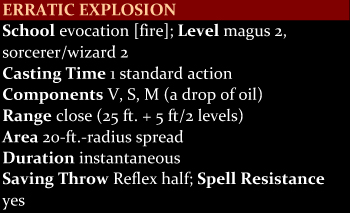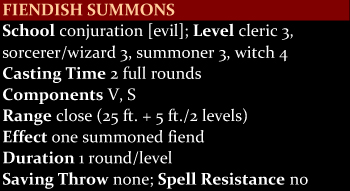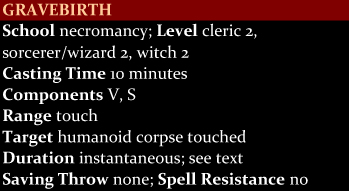Unsafe Spells II
As you have hopefully heard, we recently released A Necromancer’s Almanac: 2012, which is a compilation of all of our articles from the year of 2012, put together in a single, handy-dandy, easy-to-use book, laid out nice and neat with organized tables and alphabetized spell lists, and with updated, fixed, and cleaned-up versions of everything that needed it (plus some nifty art). This book is not only available as a downloadable .pdf for the low, low price of $9.99, but you can get a printed, paperback version of the book for a respectably low $19.99, which is a steal for no less than 300 pages of awesome gaming content.
Sorry, I got a bit side-tracked there. What I was getting at is that in order to celebrate this release, this week each of our articles is “looking back” at one of our articles in the past year, and expanding on something cool that we wish had gotten more time in the spotlight. In today’s case, the article is Unsafe Spells. The idea behind the article was that, in an attempt to make magic feel a little more arcane and mysterious, I would make some spells that could potentially backfire on the caster, if they weren’t handled with care. Basically, these were very powerful spells for their level, but they carried an inherent danger, and could kill you if you weren’t able to handle them. I thought they were pretty neat, but they tended to be kind of long, so I only ever managed to write three of them. Today’s article will double that number.
Erratic Explosion

A somewhat less popular variant of the fireball spell, this spell packs a similar punch into a much easier to cast spell, although its effects can be notably more difficult to control. Like a fireball spell, a golden bead flies forth from your finger towards a point you determine. Unlike a fireball spell, however, you must succeed on a Spellcraft check (DC 25) or the bead explodes prematurely. For every point by which you fail to meet the Spellcraft DC, the spell’s area moves 5 feet closer to you (for example, if you determined that the center of the blast would be 30 feet away from you, and got a result of 22 on your Spellcraft check, the center of the blast would be only 15 feet away from you, and you would now be in the blast, as well).
As with fireball,an early impact results in an early detonation. If you attempt to send the bead through a narrow passage, such as through an arrow slit, you must "hit" the opening with a ranged touch attack, or else the bead strikes the barrier and detonates prematurely.
Wherever the explosion occurs, it deals 1d6 points of fire damage per caster level to each creature and unattended object in the area, to a maximum of 6d6 at 6th level. The explosion sets fire to combustibles and damages objects in the area. It can melt metals with low melting points, such as lead, gold, copper, silver, and bronze. If the damage caused to an interposing barrier shatters or breaks through it, the explosion may continue beyond the barrier if the area permits; otherwise it stops at the barrier just as any other spell effect does.
Fiendish Summons

You call forth an evil outsider to do your bidding. You may summon any creature with the outsider type and the evil subtype with which you are familiar (either you have encountered creatures of that type personally, or you succeed on a Knowledge [planes] check to identify them). In order to successfully summon the creature, however, you must succeed on a Spellcraft check (DC 10 + twice the summoned creature’s CR). If you succeed on the check, the creature is summoned and serves you faithfully in a way identical to creatures summoned by the spell summon monster I.
If you fail this check by less than 5, the spell is simply wasted, and nothing happens. If you fail the check by 5 or more, then the creature in question may, at its discretion, choose to answer the summons anyway, but in such cases the creature is not under your control. Not only can it do as it pleases (which almost always involves killing the caster, if not worse things), but the summoned creature is automatically aware of your direction and relative distance, it gains a +2 profane bonus on attack rolls and damage rolls made against you, and you suffer a -2 penalty on saving throws made to resist its spells, as well as its spell-like, supernatural, and extraordinary abilities. If the creature does choose to appear in this manner, it remains for the spell’s full duration (you can’t dismiss the effect) before returning whence it came. Once the creature returns to its home plane, it no longer gains any of the above benefits, but it still remembers you, and may seek to further torment you at a later date.
Gravebirth

With this spell, you siphon some of your own life energy into the target, transforming it from a lifeless corpse into a hungry wight. When you begin casting this spell, you immediately take 2d6 points of damage, which is not subject to damage reduction. If this damage is reduced or prevented in any way, the spell automatically fails. Once the spell is complete, the corpse rises as a wight, whose current hit points are equal to the amount of damage you took as part of casting the spell (determine its maximum hit points normally).
The life-hungry undead attempts to continue siphoning life energy from you, and you must succeed on a Spellcraft check (DC 23) to stop it. A natural 1 on this check is automatically considered a failure. If you fail the check, you suffer 2d6 points of damage, and the wight heals the same amount. You may make a new Spellcraft check to attempt to stop the siphoning process each round, and continue taking 2d6 points of damage per round until you succeed.
If you successfully stop the siphoning process, the wight falls under your control, as though it had been created by the spell animate dead, except that it does not count against the number of Hit Dice of undead you can control with that spell. If you fail to stop the siphoning process, then once you are slain, the wight is uncontrolled. You cannot prevent the wight from siphoning life from you except by destroying it or succeeding on the Spellcraft check, and no amount of distance, or even being on another plane can prevent the wight from siphoning life in this way.
As long as the wight remains undestroyed, the link between you and it remains, and, once per week, it will attempt to begin siphoning life energy from you again (this functions identically to the initial life siphoning, and must be stopped in the same way). At the same time, however, you can use this connection to empower your wight. In a short ritual that takes 10 minutes to complete, you may gain 1d4 temporary negative levels in order to bestow a permanent class level on the wight. Doing so re-opens the link for life-siphoning, and you must stop the wight from draining your life energy again (any penalties from the negative levels apply to the Spellcraft checks as appropriate. If you are immune to negative levels or otherwise avoid gaining these negative levels, the process simply fails).
Empowering the wight in this way, or being linked to more than one wight at a time with this spell, can be incredibly dangerous: the Spellcraft DC to stop the life siphoning process for a specific wight increases by +2 for each Hit Dice that wight possesses beyond its initial 4. Additionally, for each wight you are linked to beyond the first, the DC to stop the siphoning process increases by +4 for any wight you are linked to in this way.
Finally, whenever a wight created by this spell dies, you gain 1 temporary negative level from the shock of your link with the creature being severed.


